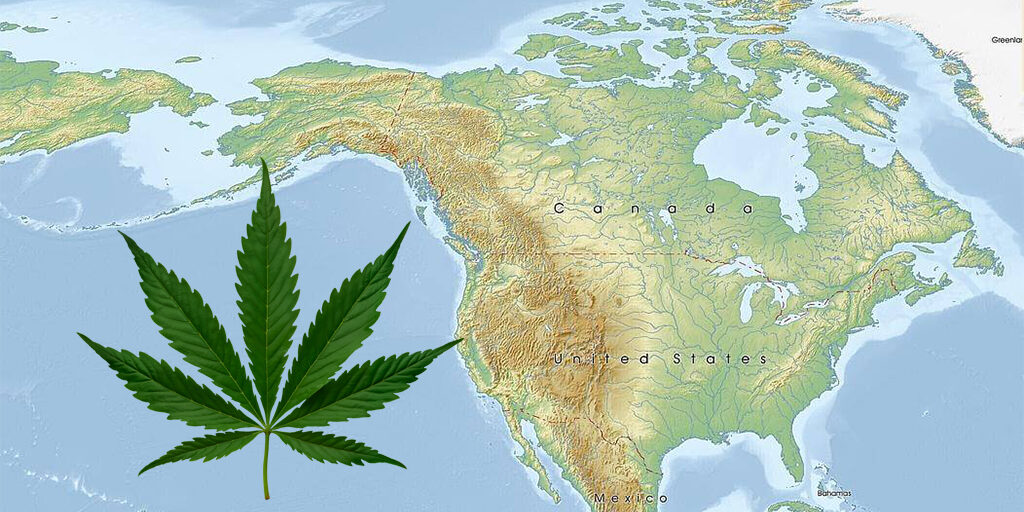Cannabis legalization has rapidly evolved in North America over the past two decades. While Canada has fully embraced legal cannabis on a national level, the United States remains fragmented, with different states adopting varying degrees of legalization. Mexico has also made strides toward legalizing cannabis but faces regulatory challenges. As the legal landscape continues to shift, the future of cannabis legalization in North America appears promising, with trends pointing toward increased acceptance, regulatory advancements, and economic opportunities.
Current State of Cannabis Legalization

Canada: A Fully Legal Market
Canada became the first G7 country to legalize recreational cannabis nationwide in October 2018. Under the Cannabis Act, adults can purchase, possess, and grow cannabis within regulated limits. The legal market has grown significantly, generating billions in revenue and creating thousands of jobs. However, the country still faces challenges, such as competition from the black market, high taxation, and regulatory restrictions that impact industry growth.
United States: A Patchwork of Laws
Cannabis remains federally illegal in the U.S. under the Controlled Substances Act, classified as a Schedule I drug alongside heroin and LSD. However, individual states have taken their own paths toward legalization:
- Fully Legal: 24 states, including California, New York, and Illinois, allow both medical and recreational use.
- Medical-Only: 38 states permit medical cannabis use.
- Prohibited: Some states, such as Idaho and Nebraska, still prohibit cannabis in all forms.
Despite federal prohibition, the cannabis industry in the U.S. is thriving, with states generating billions in tax revenue. Efforts to pass federal legalization measures, such as the SAFE Banking Act and the MORE Act, continue to gain traction in Congress.
Mexico: A Legal Gray Area
Mexico’s Supreme Court ruled in 2018 that prohibiting cannabis was unconstitutional, setting the stage for legalization. In 2021, the Mexican government passed a bill allowing adults to possess and grow cannabis for personal use. However, regulatory frameworks have yet to be fully implemented, leading to a legal limbo that creates uncertainty for businesses and consumers alike.
Trends Shaping the Future of Cannabis Legalization
1. Federal Legalization in the United States
One of the most anticipated developments is the possibility of federal legalization in the U.S. Several bills have been introduced in Congress to address banking restrictions, criminal justice reform, and full-scale legalization. If passed, federal legalization would:
- Open up banking services for cannabis businesses.
- Allow interstate commerce, reducing operational costs for businesses.
- Standardize regulations across states, creating a more consistent market.
2. Increased Medical Cannabis Research and Acceptance
 Medical cannabis is widely accepted across North America, and research continues to uncover its benefits for conditions such as chronic pain, epilepsy, and PTSD. As more clinical studies provide evidence of cannabis’s medical potential, governments may ease restrictions on its use, leading to wider access and insurance coverage.
Medical cannabis is widely accepted across North America, and research continues to uncover its benefits for conditions such as chronic pain, epilepsy, and PTSD. As more clinical studies provide evidence of cannabis’s medical potential, governments may ease restrictions on its use, leading to wider access and insurance coverage.
3. Economic Growth and Job Creation
The cannabis industry has become a significant economic driver, with estimates predicting the global market could reach $100 billion by 2030. In North America:
- Canada’s legal cannabis industry contributed over $17 billion to GDP in 2022.
- The U.S. cannabis industry employs over 400,000 people, with job growth expected to rise as new markets open.
- Mexico has the potential to become a key player in cannabis exports if regulations are solidified.
4. Social Equity and Criminal Justice Reform
A major component of cannabis legalization involves addressing the harms of past prohibition. Many U.S. states have introduced social equity programs that aim to provide opportunities for communities disproportionately affected by the War on Drugs. Expungement of cannabis-related criminal records and reinvestment in affected communities are key priorities for future legalization efforts.
5. Normalization and Social Consumption Spaces
Cannabis consumption is becoming increasingly normalized, much like alcohol. Social consumption lounges, where people can legally consume cannabis in designated areas, are emerging in states like California and Nevada. If more jurisdictions adopt these models, cannabis culture could shift from private use to a more social and regulated experience.
6. Technological Advancements and Innovation
Innovation is playing a major role in shaping the future of cannabis, from cultivation to retail. Key advancements include:
- Genetic Engineering: Creating strains with specific cannabinoid profiles for medical and recreational purposes.
- Nanotechnology: Developing fast-acting edibles and beverages for a more predictable cannabis experience.
- Automated Cultivation: AI and machine learning optimizing cannabis production for efficiency and quality control.
Challenges to Overcome

1. Regulatory Inconsistencies
The patchwork of regulations across North America creates challenges for businesses and consumers. A unified approach, especially in the U.S. and Mexico, would streamline the industry and make it easier for companies to operate across borders.
2. Black Market Competition
Despite legalization, the black market remains strong due to high taxation and regulatory costs that make legal cannabis more expensive. Addressing these issues through tax reductions and better enforcement could help shift consumers toward legal markets.
3. Banking and Financial Restrictions
Cannabis businesses in the U.S. face difficulties accessing banking services due to federal prohibition. Without access to loans and financial services, many small businesses struggle to compete with larger corporations.
4. International Trade Barriers
While Canada and Mexico could benefit from cannabis exports, international trade remains restricted due to varying global regulations. If more countries legalize cannabis, North America could become a leading exporter of high-quality cannabis products.
What Lies Ahead?
The next decade is likely to bring significant changes to cannabis legalization in North America. The most probable developments include:
- Federal legalization in the U.S. within the next five years.
- Mexico finalizing its regulatory framework, creating a legal market.
- Canada refining its policies to better compete with illicit sales.
- Expansion of social consumption spaces and cannabis-friendly tourism.
- More investment in cannabis research, leading to new medical applications.
As public support for cannabis legalization continues to grow, North America is poised to become a global leader in the cannabis industry. By addressing regulatory challenges and embracing innovation, the region can set the standard for a sustainable and inclusive cannabis market.
Final Thoughts
The future of cannabis legalization in North America is bright, with progress being made on multiple fronts. While challenges remain, the industry’s economic potential, medical benefits, and evolving public perception indicate that further legalization and regulation are inevitable. Whether you’re a consumer, business owner, or policymaker, staying informed about these trends will be essential in navigating the ever-changing cannabis landscape.

